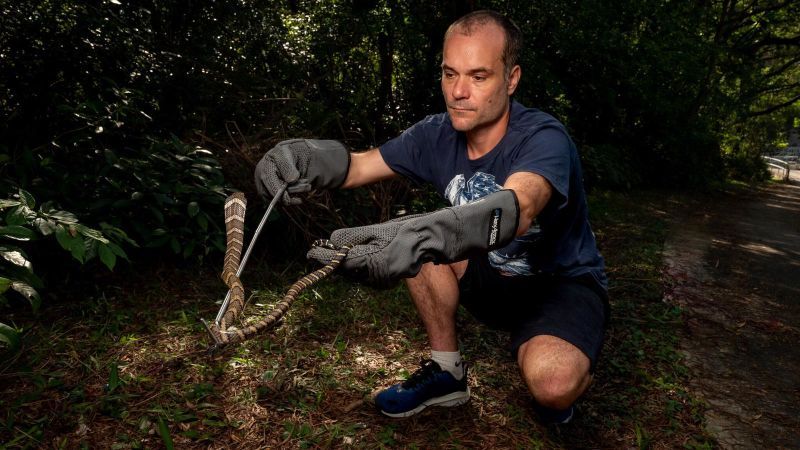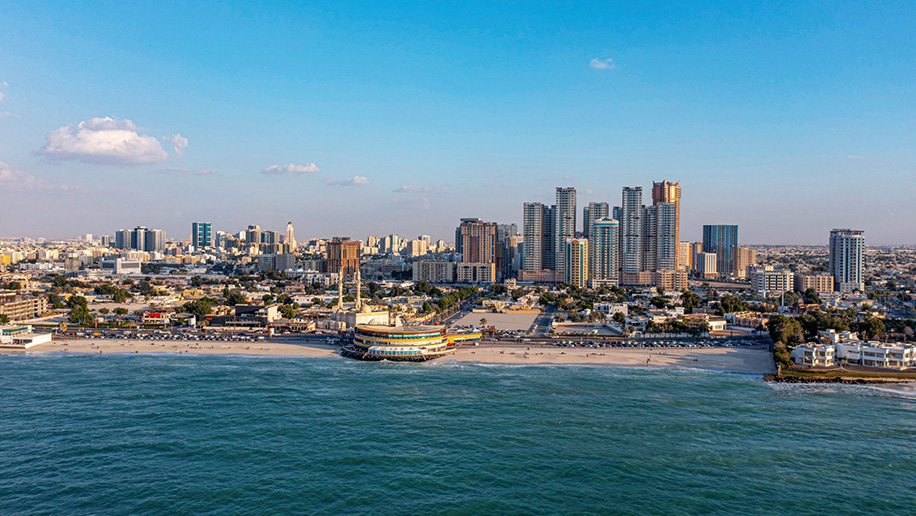Editor's note: Monthly Ticket is a CNN travel series that highlights some of the most fascinating topics in the world of travel. In October, we shifted our focus to the offbeat, highlighting everything from (supposedly) haunted spaces to abandoned places.
Hong Kong
cnn
—
A split second after William Sargent's torchlight catches the unmistakable glow of snakeskin, he springs into action with a roar, donning a protective glove and launching into the dense, green jungle of northern Hong Kong.
Moments later, the 46-year-old reappears on the paved trail with a many-banded krait, also known as Bungarus multicinctus, a species covered in black and white zebra-like stripes that is one of the most venomous snakes in the world. world.
“This is a real beauty, it's stunning,” says Sargent, sweat gathering on his forehead as he struggles to keep the lively reptile from escaping his grasp. “If there was an elite model for snakes, this would be up there. But this is the one you really don't want to bite you. If left untreated, he could suffer respiratory failure and die.”
Since 2017, Sargent, a police-approved snake expert, has been organizing so-called nighttime “snake safaris” through Hong Kong's green, biodiverse terrain, such as Tai Mo Shan Country Park, home to the highest peak. of the city in upstate New York. Territories Region: attracts hundreds of daring visitors every year.
The Brit moved to the city at the age of two, honing his passion for herpetology (the study of amphibians and reptiles) while exploring Hong Kong's lush subtropical landscapes as a teenager. In addition to serving his own interests, the tours are a way for Sargent to combat stigma, improve awareness and foster appreciation for snakes.
“The vast majority of snakes that appear in your house do not want to live there. It’s just a circumstance, like a fish jumping in your boat,” she says. “If you are sensible, there is nothing to fear. But unfortunately, many snakes die from fear.”
While Hong Kong is a global metropolis almost as large as Los Angeles, containing some of the most densely populated districts in the world, around 40% of its area is protected rural parks, meaning its 7.3 million residents They often come into contact with wildlife, including the city's more than 50 species of snakes, from the potentially deadly king cobra to the Burmese python, which can grow to more than 26 feet.
“Considering its size, Hong Kong has a disproportionately high number of snakes,” says Dr. Sung Yik-hei, a professor at Lingnan University and one of the city's leading reptile experts. “That's because of the city's wide variety of habitats: mountains, coastal areas, lowlands, wetlands and freshwater streams.”
Despite this wealth of reptiles, there are just over 100 snake bites in Hong Kong each year (the chance equivalent to about one in 50,000) and the latest death was that of a trader who defanged a non-native snake. for which there was no antidote in 1988. .
“The probability of encountering a snake is not low,” adds Sung. “But the chance of being bitten is very low. Even if it is, Hong Kong is one of the safest places in the world for snakebites due to the quality and proximity of the hospitals.”
For his part, Sargent gets calls every week to capture snakes everywhere, from schools to prisons to homes, and once, a beach on Lantau Island to catch a 15-foot python. As of August, he is the first expert to participate in a “Rapid Release Program,” which means that instead of having to go through a bureaucratic procedure that lasts several days, sending a captured snake to a police station and other facilities , you can free it. in the nearest country park, reducing the workload and keeping the snakes much healthier.
That policy change has proven to be an uphill struggle amid a complex cultural context.
In Hong Kong, snakes are eaten in soup, used in traditional Chinese medicine, or simply considered a threat. The result is that in China almost all of the largest snake species are classified as vulnerable, threatened or endangered on the International Union for Conservation of Nature (IUCN) Red List, which tracks the conservation status of the species of plants and animals in the world.
But thanks to Sargent – who has given talks at local schools and created a Facebook group, Hong Kong Snakes (whose 15,000 members exchange photos, information and advice on snake encounters) – snakes are shedding that fearsome reputation.
Tour attendee and Facebook group member Michelle Yu, who moved to Hong Kong from Washington DC nine years ago, says her perception of snakes has been completely transformed thanks to the community. “You go from being repulsed to actively seeking out these beautiful creatures,” she explains.
For others, the experience underscores the unique contrasts available in Hong Kong: towering skyscrapers alongside exotic nature. “You have the great feeling that you can escape the city,” says Loïc Sorgho, a 42-year-old French banker. “Where else can you go from a 50-story building to a tropical jungle so quickly?”
Over the course of a couple of hours, the group encounters nine different snakes: three bamboo vipers; two diamond-backed water snakes; a bicolor brook snake; a simulated viper; a greater green; and the krait of many bands, whose diaphanously soft diaphragm Sargent offers to the audience to caress. “Please don't touch more than half of his body, please,” he jokes. “It won't do any good for my insurance.”
And there are plenty of other wildlife to spot on the tour: barking deer, leopard cats, porcupines, swamp eels, birds of prey, all manner of frogs, and fire-bellied newts, whose dark undersides are dotted with bright orange spots. and red. .
Toward the end of the meandering route along rocky, bamboo-lined paths and through babbling brooks, Sargent glimpses a baby diamondback watersnake coiled around a plant and picks it up. “He's trying to stick his rear fangs into me,” he says, moments before the tip of his finger is bitten off. “Ouch! It's pretty toxic to geckos, but I'll be fine.”
Once freed, the snake, which has whitish-yellow diamond markings along its scaly body, glides across the moonlit water's surface amid a chorus of cicadas and into Hong Kong's perfectly still night. Kong.
Snake Safari in Hong Kongfrom $550 HKD ($70 US) per person












